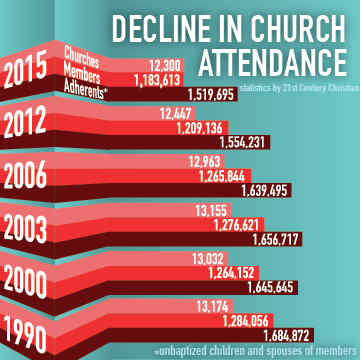In the last 25 years, the U.S. population, according to the U.S. Census Bureau, has grown from nearly 250 million to 321 million — adding a total of 71 million people. Therefore, one could assume an increase in church membership across the U.S. would be a plausible consequence of this population rise, but a study from 21st Century Christian’s “Churches of Christ in the United States” says otherwise.
The April 2015 study by 21st Century Christian found that in the last quarter-century, total church of Christ membership in the U.S. has fallen to 1,183,613 — that is down 7.8 percent, or 100,443 people, since 1990. The same study also found that the number of church congregations has dropped to 12,300 from 13,174.
“These statistics matter because every number represents a soul and a person that needs to have a savior,” Dr. Dan Williams, vice president of church relations, said.
This decline in church attendance is not just contained to the churches of Christ. According to Williams, no demographic in America is experiencing an increase in church attendance.
“Anytime you have a phenomenon that is wide spread among all demographics you have to look for a cultural explanation,” Williams said.
This summer, more than 100 church leaders from four different states attended a seminar at Harding to find that explanation.
“President of the Barna Group David Kinnaman, who has done one of the largest studies of religion in America, came to speak about the cultural trends in the country,” Williams said. “He also spoke on the fact that there is a significant increase in the number of people who are not connected in any meaningful way to a church.”
Kinnaman named growing secularization, distrust in institutions in general and changes in culture as possible reasons for this decline in church attendance.
Also discussed at the seminar was the topic of millennials’ role in this decline.
“Churches need to start focusing on connecting with younger adults through relationships,” Williams said.
According to Kinnaman’s book “Churchless,” millennials and young adults have the “highest levels of church avoidance.” A Barna Group study found that six out of 10 “twenty-somethings” who were involved in a church during their teen years have failed to transfer that spiritual activity to their young adult years.
Dr. Joe Brumfield, professor of Bible, conducts anonymous student questionnaires and has collected over 14,000 surveys over the course of 20 years. In his findings, he concluded that another core problem of the church membership decline amongst millennials comes back to the parents.
“There are cultural and media effects, no doubt, but my suspicions are that kids today, in their actions, are reflecting the true secret values of their parents,” Brumfield said.
Brumfield said it is an issue of kids’ perception of the genuineness of their parents’ faith walk.
“They are our children and they are the logical response to our behavior,” Brumfield said. “They see us passing the communion plates on Sunday morning and watching ‘Dirty Dancing’ on Sunday night. That’s the problem.”
Visibility of a church’s social work, confessional among church leaders and sexuality are other noteworthy sources of church cynicism among millennials, according to Brumfield.
“Sadness,” President Bruce McLarty said. “That’s my initial response to these statistics, but my second response would be a bit of caution about what you do with these numbers.”
McLarty warns of using single-factor analysis in numbers. He emphasizes the importance of looking at multiple factors affecting a problem before jumping to a conclusion or solution.
“Whatever Harding’s prescription to this problem is, it cannot take away the free will choice of people to decide for themselves,” McLarty said. “But we can do our best to lead people in the right direction.”
No matter the cause of the problem, Williams said one solution is vital.
“We can no longer just assume that people have a Bible background, that people are interested in church or understand the significance of church and Christianity,” Williams said. “We’re going to have to light our candle in the darkness and become more mission minded.”
Part two of “The millennial Exodus: real response from the absent generation,” will appear in next week’s issue of The Bison, on stands Friday, Oct. 16.
